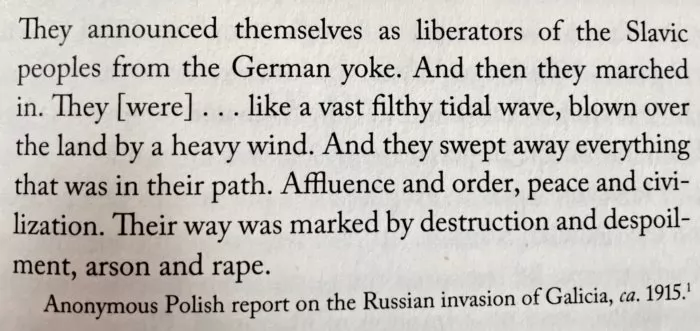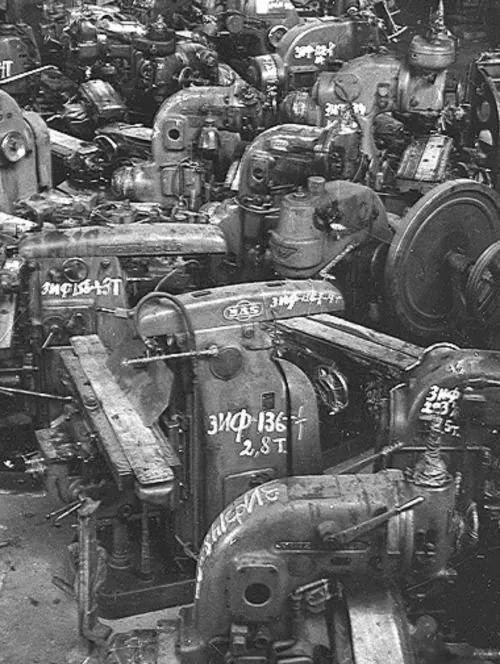Marauding represents a breakdown in military command and control where soldiers become uncontrollable and begin acting outside the standard system of rules that govern military behavior. However, history shows that the armies of both Imperial Russia and the Soviet Union were allowed to loot and steal. Historian Roman Ponomarenko analyzes the legacy of Russian looting and its ongoing consequences in the brutal Russo-Ukrainian war of 2022.

Traditional pillaging becomes “law” under the Bolsheviks
Prior to the 1917 Revolution, the Russian Imperial Army rarely went beyond the “norms” of its time in terms of looting. But, there were instances of widespread military marauding. For example, historians chronicled the ruthless character of the Russian Army as it advanced into eastern Halychyna (Galicia). The principal city, Lemberg (now Lviv) fell into Russian hands on 3 September, 1914. Throughout the occupation, the Tsarist officials pursued a policy of integrating Galicia with the Russian Empire, forcibly russifying Ukrainians, and confiscating all assets and property. After seizing power in Petrograd and Moscow in October 1917, the Bolsheviks built a completely new army, which was to carry the communist revolutionary idea to the world at large. At the same time, Lenin’s party began expropriating private and state property and valuables under the slogan “Steal what’s already been stolen!” (“Грабуй награбоване!”). The seized funds and assets were then used to support the regime, subsidize the “world revolution” and purchase weapons.
After seizing power in Petrograd and Moscow in October 1917, the Bolsheviks built a completely new army, which was to carry the communist revolutionary idea to the world at large. At the same time, Lenin’s party began expropriating private and state property and valuables under the slogan “Steal what’s already been stolen!” (“Грабуй награбоване!”). The seized funds and assets were then used to support the regime, subsidize the “world revolution” and purchase weapons.

“I don’t find anything wrong with using the slogan - “Steal what’s already stolen!” - in terms of our history. After all, we’re ready to use the phrase “expropriation of the expropriators”, so can’t we just do without Latin words and use our own?The American historian Sean McMeekin notes that the Bolsheviks distorted and ideologically interpreted the idea of property and understood law and morality in a completely different way. The Bolsheviks, like the French 19th century socialist Pierre-Joseph Proudhon, believed that property in itself represented a kind of theft. Lenin claimed that his government was only stealing what had already been stolen, because the wealth accumulated by the aristocracy, industrialists, merchants, and bureaucrats had been previously stolen from the proletariat and was now being justifiably returned. McMeekin underlines that not all the Bolsheviks believed this rhetoric, but it suited many and justified their heinous deeds. Thus, the Red Army became an instrument of mass theft. The call to steal and loot attracted the dregs of society to the ranks of the Red Army. In fact, many criminals volunteered to join not because they believed in Lenin’s revolutionary ideas, but in order to get weapons and have the right to pillage and plunder.

Military marauding – a conscious Russian tactic
In December 1918, Bolshevik troops invaded the Ukrainian National Republic (UNR). Mikhail Muraviov, who commanded the attack on Kyiv, encouraged his soldiers to crack down on the “enemies of the revolution” and promised to let them loot and plunder Kyiv.
“Our worst enemy couldn’t have done us more harm than Muraviov with all those massacres, executions, his despotic nature and giving his soldiers the right to plunder cities and villages. And, he did this in the name of the Soviet government, turning the entire population against us. His tactics consisted of stealing and violence. He achieved instant success, but such tactics ultimately led to defeat and disgrace.”However, other Bolsheviks, such as Volodymyr Antonov-Ovseenko and Mykola Muralov, defended Mikhail Muravyov. They did not perceive his actions as a crime and argued that looting did not harm their cause. In June, Muraviov was acquitted and was deployed as commander to the Eastern Front, where he organized a revolt against the Bolsheviks and was shot while resisting arrest. The Russian Civil War, with its official slogan “Steal what’s already been stolen!” and mass looting disguised as “expropriation”, continued until the end of the war. By December 1921, the Bolsheviks had sold $1.2 billion worth of jewelry and valuables to different western buyers (approximately $120 billion in current money). But, many Russian commanders and ordinary Red Army soldiers literally pocketed thousands of priceless items and brought them home.

Wristwatches - the most coveted trophies of war

“I noticed that to my left, the guys were collecting “trophy” watches. So, I turned to them [the German prisoners]: ‘Now I ask you to give this Soviet officer a good-quality watch.’ There was a moment of hesitation. The Germans were somewhat confused by what I meant by a ‘good-quality watch’. So, I told them to give me all they had, and in an instant the pockets of my uniform were filled with all kinds of watches.”
Zhukov filled seven train wagons with stolen furniture
Trending Now

“In all rooms of his dacha, on windows, shelves, tables and bedside tables we found many bronze and porcelain vases, statuettes, as well as various foreign-made items. It seems that all the objects - starting from furniture, carpets, dishes, decorations and ending with the curtains – come from other countries, mainly Germany. There is literally nothing of Soviet origin in the dacha, except for the paths that lead to Zhukov’s home. We found no Soviet books, but we documented many German works in beautiful bindings with gilt embossing.”
“The Russians have outdone the Chinese in the Far East!”
Most Russians continue to believe that Soviet soldiers were allowed to do as they please during WW II, because they were taking revenge for the Nazi crimes committed in the USSR. Thus, not only looting and pillaging, but also rape and senseless violence were justified. Soviet soldiers behaved in the same way in other European countries, particularly in Yugoslavia and Hungary. In February 1945, the Hungarian communists of the town of Kőbánya (now a district of Budapest) wrote an appeal to the Soviet command.“Drunken soldiers raped mothers in front of their children and husbands. Twelve-year-old girls were taken from their parents and gang-raped by groups of 10-15 soldiers, many of whom had sexually transmitted diseases. One group finished; another group replaced them. Several of our comrades were killed while trying to protect their wives and daughters ... The Russian soldiers continue looting to this day.”The Soviet soldiers behaved in the same way in the Far East in the summer of 1945. US military officials recalled that Soviet soldiers in Shenyang raped women at bus stops, train stations, and sometimes directly on the streets.
“The Russians have outdone the Chinese in looting, pillaging and rape. The Red Army steals and kills. And they steal from everyone, not only from the Japanese. Some Soviet soldiers wear a dozen watches on their arms…” said the head of POW repatriation missions.

“Russian soldiers broke into homes and carried away everything they could, except for the large pieces of furniture. Then, a military truck pulled up and picked up the furniture. Soviet officers usually overlooked the thefts and crimes committed by their soldiers, and often took part in them themselves.”
The Gold of Ancient Troy and the Russian legacy of military marauding
During the war, the Soviet authorities were ready to legalize looting, so they created the Central Trophy Department. According to the department’s official data, 21,834 wagons of assets and 73,493 wagons of building materials and “apartment goods and valuables” were removed from the Soviet zone of occupied Germany.These included: 174,151 kilos of gold, silver and platinum, 60,000 grand pianos, 190,000 carpets, 460,000 radios, 265,000 grandfather clocks, 940,000 pieces of furniture, 1.2 million coats, 1 million hats and 20 million litres of alcohol.

Following in the footsteps of the Soviet Army
The modern Russian Army is a direct descendant of the Soviet Army. The behaviour of Russian soldiers in Ukraine testifies not only to the prolongation of “traditional military marauding”, but also to widespread poverty in the depressed regions of the Russian Federation. A case of looting was recorded by surveillance cameras in Sumy Oblast in mid-June, 2022. Video: Inform Napalm [embedyt] https://www.youtube.com/watch?v=k_rL0wfnI-8[/embedyt] As of the early 1990s, the Russian Federation was involved in several conflicts, during which marauding and plundering was officially approved. The Chechen wars in the 1990s were perceived as an internal conflict, which allowed the Russians to hide the some of the world’s greatest war crimes. The Russo-Georgian war erupted in 2008. The Russian army razed towns and villages, followed by armed militias that engaged in plundering, rape, burning and kidnapping. Former Georgian MP Givi Targamadze recalls:“They behave like medieval hordes. They steal computer equipment… well, I guess that’s all right. But household items, kitchen stools?! I don’t know what planet they live on. Apparently, the Russians have neither military bases nor normal houses. They probably don’t get paid, but are instead encouraged to engage in looting during such raids.”There was no lack of pillaging during the 2014 Russian invasion of the Ukrainian Donbas. When the Russian-backed militants shot down the Malaysia Airlines MH17 aircraft in the Donbas on 17 July 2014, the world watched in horror as the killers walked among the scorched debris, searching the bodies, and collecting valuables and personal items at the crash site of the Boeing 777.
Russia’s policy of terror
It is no surprise to see a repetition of such gruesome activities during Russia’s large-scale invasion of Ukraine. In April, the Russian army left Bucha, Irpin, Borodianka, and other cities in Kyiv Oblast, leaving a trail of destruction and horror. A few days later, social media users saw videos of Russian soldiers in a Belarusian shipping service sending home hundreds of parcels with items and appliances looted in Ukraine. Thanks to footage from three-hour video surveillance cameras, many war criminals have been identified.
“The Russian occupiers have one goal - to strengthen their positions, hiding behind the local population. At the same time, some of Putin’s troops are cut off from supplies and have been instructed to “provide for themselves” until further notice. This means that Russian soldiers are allowed to steal everything and anything from the local population, and rob warehouses, shops, and pharmacies... This is Russia’s policy of terror, and it’s formally encouraged by its high command.”In total, Russian soldiers have reportedly stolen one hundred kilos of private assets per head, but only because this is permitted. And the fact that the Kremlin and Russia’s military command tolerate looting is evidenced by official permission to use military equipment to transport washing machines, plasma-screen TVs and other stolen items. A call allegedly intercepted by the SBU/SSU between a Russian soldier and a woman. The soldier explains that he is taking part in looting and pillaging. He confirms that Putin allowed it and gave orders not to prosecute soldiers for stealing. Video: Armed Forces of Ukraine [embedyt] https://www.youtube.com/watch?v=UvbrH5W_3ZU[/embedyt] At present, the situation is not getting any better as the Russian occupiers have Moscow’s official permission to rob Ukrainian museums, industrial enterprises and warehouses. Grains and cereals grown on Ukrainian soil, as well as metal products are shipped by land and sea to Russia.

- The Kherson “referendum” sham: out of the Kremlin’s hybrid war playbook
- Russia’s war destroys Ukraine’s economy, spurs global food and economic crisis
- The scope of the EU energy dependence on Moscow and practical ways out
- Whole world must unite against fossil fuels, dictators & wars – Ukrainian NGO
- How Russia justifies the murder of Ukrainians: Russia’s 2022 “genocide handbook” deconstructed
- “Russians almost prepared, waiting when rain ends” – battlefront governor on impending...
- As Russia’s war against Ukraine escalates, the threat of hunger looms over...
- Bucha: a turning point–not only in Putin’s war in Ukraine, but in...

